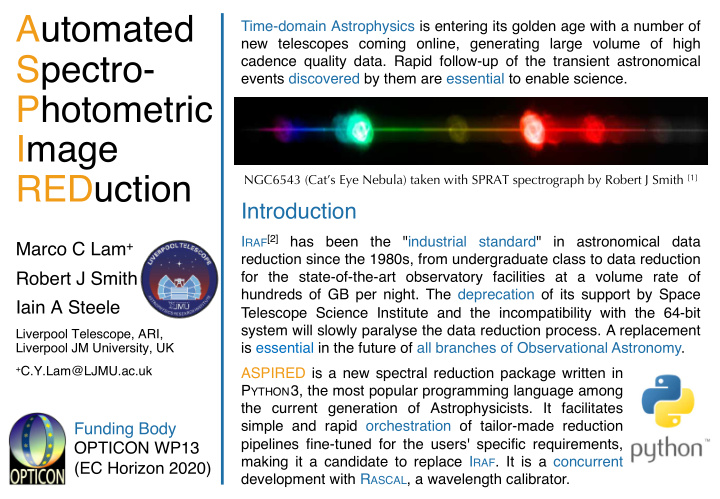



Automated Time-domain Astrophysics is entering its golden age with a number of new telescopes coming online, generating large volume of high Spectro- cadence quality data. Rapid follow-up of the transient astronomical events discovered by them are essential to enable science. Photometric Image NGC6543 (Cat’s Eye Nebula) taken with SPRAT spectrograph by Robert J Smith [1] REDuction Introduction I RAF [2] has been the "industrial standard" in astronomical data Marco C Lam + reduction since the 1980s, from undergraduate class to data reduction Robert J Smith for the state-of-the-art observatory facilities at a volume rate of hundreds of GB per night. The deprecation of its support by Space Iain A Steele Telescope Science Institute and the incompatibility with the 64-bit system will slowly paralyse the data reduction process. A replacement Liverpool Telescope, ARI, is essential in the future of all branches of Observational Astronomy. Liverpool JM University, UK + C.Y.Lam@LJMU.ac.uk ASPIRED is a new spectral reduction package written in P YTHON 3, the most popular programming language among the current generation of Astrophysicists. It facilitates simple and rapid orchestration of tailor-made reduction Funding Body pipelines fine-tuned for the users' specific requirements, OPTICON WP13 making it a candidate to replace I RAF . It is a concurrent (EC Horizon 2020) development with R ASCAL , a wavelength calibrator.
Doing Science with a Spectrum Spectrum and Spectrograph The spectra below show four strong and broad An electromagnetic spectrum is the entire range absorption features. The physical processes of wavelengths of electromagnetic radiation. behind them always produce them at those specific Each source has its characteristic emission or wavelengths in the source. Measuring the strength, absorption features. Spectrographs are used to shape, shift and broadening of the features allows disperse the incident light into a spectrum and us to derive the intrinsic properties of the source record the data with a detector (e.g. CCD). The that created and modified the appearance of the “rainbow spectrum” is the visible range that can spectrum as observed on Earth. be seen by the naked eye, from 390 to 700 nm. Cartoon of the basic design Light Source of a spectrograph (e.g. Sun) Dispersion Element (e.g. prism, grating) Short Wavelength (blue) S II UV Infrared Fe II Si II Mg II Long Wavelength (red) Different responses recorded by the camera of the same source (ASASSN14gh) using red and blue optimised dispersion gratings Detector Camera on the SPRAT spectrograph [3] on the Liverpool Telescope.
Dispersion Direction (wavelength direction) Data Processing and Extraction Spectral data extraction follows 4 steps: ▲ 1. 2D image of a spectrum from LT/SPRAT. The vertical lines Spatial Direction 1 :: Image Flattening show the emission spectrum of our atmosphere. The horizontal This step corrects for the varying optical line is the astronomical spectrum dispersed by the grism. The and detector behaviour across the image. dashed line show the trace of the spectrum. The processed image reproduce the signal ◀ 2. The extracted spectrum that a uniform detector should produce. (blue) and the quality of the 2 :: Spectral Tracing & Extraction spectral signal (grey). The sky emissions are subtracted in the The spatial positions of the 2D spectrum extraction process to give the are identified along the dispersion direction. spectrum of the target only. The signals are then summed to give the response as a function of the dispersion. 3 :: Wavelength Calibration The dispersion-to-wavelength relation has to be applied to the spectrum before it can enable science. It works by comparing ▲ 3. A spectrum of a Xenon arc lamp from LT/SPRAT. The arc lines are at well known wavelength such that we can compute against the spectrum from an arc lamp with a function to describe the position-to-wavelength relation. the known position-to-wavelength relation. ◀ 4. The wavelength and flux 4 :: Flux Calibration calibrated spectrum (blue) of a Detector sensitivity varies as a function of typical M dwarf star showing wavelength, so the signal requires a many absorption features due scaling. This is done by applying the to its atmosphere. This can be compared against models for sensitivity of the instrument computed from further scientific investigation. a standard star with well-known flux. Wavelength / Angstrom
Software Stack Usage The ASPIRED uses a number of popular and ASPIRED is still undergoing development, but well-maintained packages including A STROPY [4] , three data pipelines are already building on top of N UM P Y [5] , S CI P Y [6] , R ASCAL [7] , S PECT R ES [8] , and it: an upgrade of the LT/SPRAT pipeline, a new instrument SAAO/Mookodi [9] , and an observation their associated dependencies. They allow BlackholeTOM [10] simple maintenance and housekeeping. broker at the University of Warsaw. The continuous development will carry on for at least 2 more years, funded by the Tel-Aviv University from October 2020. Software Versioning, Continuous Integration and Automated Documentation are enabled with GitHub , Travis CI and Readthedocs (Rtd) . With every new commit is made to GitHub , Travis CI will be triggered automatically to test the compilation as well as any other test cases provided, while Rtd generates new documents Reference to update the differences made in the most recent commit. The installation guide and user [1] http://telescope.livjm.ac.uk/News/Archive/index.php?sf=s20160924 [2] Tody D., 1986, SPIE, 627, 733 menu including examples are available at the [3] Piascik, A. S, et al. in Proc. SPIE, vol. 9147 of Society of Photo- Rtd link (see below). Optical Instrumentation Engineers (SPIE) Conference Series, 91478H [4] Astropy Collaboration, et al. 2018, AJ, 156, 123.1801.02634 [5] Walt, S. v. d, et al. 2011, Computing in Science and Engg., 13, 22 [6] Virtanen, P., et al. 2019, arXiv e-prints, arXiv:1907.10121 [7] Veitch-Michaelis J., Lam M. C., 2019, arXiv, arXiv:1912.05883 GitHub: https://github.com/cylammarco/ASPIRED [8] Carnall, A. C. 2017, arXiv e-prints, arXiv:1705.05165 Readthedocs: https://aspired.readthedocs.io/en/latest/ [9] https://topswiki.saao.ac.za/ arXiv: https://arxiv.org/abs/1912.05885 [10] http://visata.astrouw.edu.pl:8080/bhlist/
Recommend
More recommend